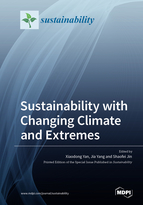Sustainability with Changing Climate and Extremes
A special issue of Sustainability (ISSN 2071-1050). This special issue belongs to the section "Air, Climate Change and Sustainability".
Deadline for manuscript submissions: closed (30 June 2022) | Viewed by 70775
Special Issue Editors
Interests: biogeochemistry; climate downscaling; ecological climatology
Special Issues, Collections and Topics in MDPI journals
Interests: remote sensing and GIS applications in land ecosystems; land cover and land use change; terrestrial ecosystem modeling; fire ecology
Interests: forest ecology; climate change; silicon cycle; carnon cycle; plant–soil interaction
Special Issues, Collections and Topics in MDPI journals
Special Issue Information
Dear Colleagues,
Climate change and extreme events are receiving increasingly more attention in the global sustainable development sphere. Identifying the impacts of climate change and extreme events is not only important in terms of natural processes, such as heat waves and earthquakes, but also in terms of societal processes and societal consequences of natural disasters. One recent extreme event, the February 2021 North American cold wave, led to widespread power outages for millions of people in Texas, USA. Another remarkable extreme event, the recent Coronavirus disease 2019 (COVID 19), is shaping the entire environmental and societal sustainability situation worldwide. With the intensity and magnitude of climate change and extreme events being unknown, neither the changing themselves nor the corresponding impacts are clear under the current circumstances.
Hence, we propose to organize a Special Issue of Sustainability on the changing climate and extremes. This Special Issue is planned to cover climate and extreme change processes, including natural processes, such as flood, heat wave, earthquake or landslide, and also to consider their impacts on natural and human dimensions: the societal and economic processes, such as economic vulnerability and social sustainable development.
Already this Special Issue has collected some papers that were presented and discussed in two workshops (held in April and May). The titles and abstracts are filed in Appendix.
Contributions to this Special Issue are invited to discuss the changing climate and extreme events, as well as their impacts on natural and human dimension sustainability, including the incorporated social–ecologic and socioeconomic processes. For this purpose, studies related, but not limited, to the following topics are invited for submission:
- Climate and extreme change, processes and assessments;
- Natural dimension response, e.g., agriculture, forest, wetland, grassland, etc.;
- Human dimension responses, e.g., economy, population, health, management, etc.;
- Related natural disasters and their impacts;
- COVID-2019 and ecological and social–ecological impacts.
Prof. Dr. Xiaodong Yan
Dr. Jia Yang
Dr. Shaofei Jin
Guest Editors
Manuscript Submission Information
Manuscripts should be submitted online at www.mdpi.com by registering and logging in to this website. Once you are registered, click here to go to the submission form. Manuscripts can be submitted until the deadline. All submissions that pass pre-check are peer-reviewed. Accepted papers will be published continuously in the journal (as soon as accepted) and will be listed together on the special issue website. Research articles, review articles as well as short communications are invited. For planned papers, a title and short abstract (about 100 words) can be sent to the Editorial Office for announcement on this website.
Submitted manuscripts should not have been published previously, nor be under consideration for publication elsewhere (except conference proceedings papers). All manuscripts are thoroughly refereed through a single-blind peer-review process. A guide for authors and other relevant information for submission of manuscripts is available on the Instructions for Authors page. Sustainability is an international peer-reviewed open access semimonthly journal published by MDPI.
Please visit the Instructions for Authors page before submitting a manuscript. The Article Processing Charge (APC) for publication in this open access journal is 2400 CHF (Swiss Francs). Submitted papers should be well formatted and use good English. Authors may use MDPI's English editing service prior to publication or during author revisions.
Keywords
- climate change
- extremes
- natural disasters
- sustainability
- natural dimension
- human dimension
- ecosystem
- agricultural system
- social system
- economy
- health
- COVID-2019








